I’ve never been a huge fan of the Guild S-200 Thunderbird because (hang on to your hats Guild fans), I think they’re goofy looking. They’re nicknamed “Gumby” for a reason, after all. I’m not without my fair share of curiosity, and I’m always willing to be proven wrong, so when a fellow LetsTalkGuild member asked me to work on his, I jumped at the chance. This particular specimen was certainly not mint, but it was structurally sound and played fine with one minor problem – two of the control pots were either dirty or had failed. Since I apparently have a reputation of caring about my work and not being “just some guy”, I was given the opportunity to fix a guitar that was nearly as old as me. My price? The ability to fondle the guitar and write this article based on my discoveries. Read on to discover how my opinion of this Guild classic went from goofy to fascinating.
If you’re looking for the Newark St. S200 T-Bird, check out my review here.
When ogling a new guitar, one of the first thing to catch a guitarist’s eye is the headstock. The headstock on this guitar is as uniquely shaped as the body, and the best word I can use to describe it is, asymmetrical. The bottom looks like it will become any other Guild headstock as the lines progress upwards, but the top just refuses to be normal. The addition of the thunderbird inlay just further adds to the uniqueness of this instrument. Speaking of inlays, the inlays on the neck are really quite beautiful. Modern plastic (or whatever they’re calling the fake stuff these days) just can’t compete with the depth and complexity of these 50-year old blocks.
No article about the S200 Thunderbird would be complete without mentioning the kickstand. This guitar has a built-in guitar stand that I’ve never seen in any other model. I don’t know that I’d use it on stage, but the feature adds to the quirkiness of the guitar in a big way, so it’s one of the first thing I showed people that saw me with the guitar. Since this wasn’t my guitar, that list included my wife, two kids, and my dogs, none of which were terribly interested, though the kids did think it was kind of cool, and to be fair, the dogs aren’t allowed in the room with the guitars, so they didn’t really get a good sniff.
The kickstand is a pretty clever design in that it’s completely unobtrusive when not in use. The guitar forms a tripod when the stand is pulled out, and there are two small feet built into the bottom of the body so that the wood doesn’t scrape on the floor when the kickstand is used. The metal leg is secured flush into the body through the use of a magnet embedded under the stand. As neat as this feature is, I’ve read a fair number of for sale ads for these guitars with broken headstock repairs due to the guitars falling over while using it.
Gadgets are fun, but how a guitar plays trumps all for me. As much as I love Guilds, I tend to shy away from the vintage models because most of the ones I’ve played had very skinny necks. This guitar does have the 1 5/8″ neck profile of older Guild electrics, but the neck was just thick enough to be comfortable, much like my 1979 S300’s neck that I loved for over 20 years. I now prefer the wider 1 11/16″ profile common on modern guitars, but with the bit of added depth, this guitar felt great in my hands.
Older Guilds aren’t known for having big frets, and this guitar was no exception. The frets definitely had that vintage feel to them, which again I had no problem with due to my having owned an older Guild for so long, but if you’re used to jumbo frets on a modern guitar, this might not be the guitar for you.
One of the reasons that I’ve never been drawn to these guitars is the fact that they’re controlled through switches. I’m not a fan of switches like this on a guitar, usually because I find them too confusing; I like guitars to be simple. Once I took this guitar out of its case, I dove in and was not at all surprised to discover that the controls were indeed confusing to my aging brain. So, I did what any self-respecting nerd with permission would do – I took it apart and traced the wiring. In all the research I did, I could not find a Guild-sanctioned reference for what the switches did, though I did find many opinions. Some said that the main switch was a pickup toggle, some said that it was a “bypass the rest of the switches” control. Some people wrote that the white switch was a phase switch, and I even saw one reference to it being a coil tap, but what was the truth? Here’s where being a nerd with a library, multimeter, and the necessary permission for dismantling a vintage instrument paid off.
The book, Guitar History Volume #5, Guild Guitars by Ted Beesley lists the controls as “Two volume, two tone, rythym/lead switch, tone switch, and two on/off pickup switches. The wiring of the guitar is a bit more complex than your typical Les Paul, but once I laid out the wiring in a logical (to me) format, it all started to make sense.
The owner sent me the guitar with the complaint that “the neck volume and tone pots are bad”, and as I played the guitar, that was the same impression I got. Unfortunately, we were both wrong. The main thing to remember about this guitar is that it is not wired like a Les Paul as you might expect given the layout of the knobs. Given the lack of a manual, the main clue lay in the size of those knobs.
The Guild S-200 Thunderbird has four knobs. There are two small knobs on top (the same knobs used as master volumes on Starfires), and two large knobs (the same G-shield 1-9 knobs used as volume and tone on early Starfires) on the bottom. The key to understanding the control layout is to think like they did in the 60s, when the neck pickup meant “rhythm”, and the bridge pickup meant “lead”. That’s what the purpose of the “master” switch is – rhythm and lead. Once I figured out what was going on, I could see why some people consider this switch to be a “switch bypass”, because that’s sort of what it does, but only as a byproduct of its intended purpose. Allow me to get technical.
When the master switch is in the up position, the neck pickup is engaged, and its volume and tone can be controlled with the top (smaller) knobs. Note that in this configuration, all other controls are bypassed! The drawing to the right shows the wiring in with the master rhythm/lead switch in the up position. When played in this configuration, the guitar sounded terrible due to the fact that both of the potentiometers in the circuit were either seized or malfunctioning, which is what led us both to believe that the neck pickup controls were bad. Since this was Guild’s first solid-body guitar, I imagine they wanted a way to make it behave like a jazz guitar where there is only a neck pickup. Whatever the reason, there isn’t much else to say about this configuration other than I imagine that most people rarely use it. Why do I think this? Because of the way the lead position of that master switch is wired.
A quick note is in order about the potentiometer values in my drawings. Though this guitar’s pots were bad (and not original), I suspect that the values of the original pots were 500k Ω for the volumes and 250k Ω for the tone knobs. Given how out-of-spec vintage knobs can be, the fact that the one good tone knob measured 350k Ω told me nothing. I’m a fan of 500k Ω pots for humbuckers, so that’s what I used.
Far more interesting to me are the possibilities that arise when the master switch is in the down position. Since I had decades of experience playing guitars with traditional toggle switches that allow for the “neck/bridge/both” choices, I naturally assumed that switching the master down would put me into the bridge pickup, and I was first dumbfounded that there was no middle position. Of course, I was wrong again.
With the master switch in the down position, the position of the other three switches comes into play. Two of the switches (colored black) control the pickups. The one in the middle adds/cuts the neck pickup, and the other black switch adds/cuts the bridge pickup. Using the switches allows either pickup to be active, both pickups to be active, or no pickups to be active, but again, only when the master switch is in the down or lead position. Notice on the drawing to the right that the white switch has been toggled up. This switch is pretty cool, but it doesn’t do what many people seem to think it does. In a nutshell, the switch adds or removes a 3300mF capacitor from the circuit, which has the effect of filtering the tone of the guitar.
Tone is a subjective thing, and for my tastes, I got the most use out of this switch with the neck pickup on and the tone rolled back. In this configuration, the guitar got muffled and woofy, as many humbucker-equipped guitars do, but with a flip of the tone switch, the woofiness was gone and the guitar sounded great, offering me a variety of tones that I couldn’t get with my Les Paul.
If you’re at all like me, then you would probably sit with the guitar and fiddle with the switches until it sounded good and then leave them alone, only to be flummoxed when someone else changed the settings after you’d forgotten the secret combination for delicious, perfect tone. Luckily, though there seems to be a lot of switches, they’re really not all that complicated.
On the three-switch panel, up means on. With either (or both) of the pickups engaged, if the tone switch is up, then the tone cap is in the path. If the tone switch is down, then the tone cap is out of the path. It’s that simple. Of course people like me try to overcomplicate things wherever possible, so I had to trace the wires to figure it all out. Hopefully my obsession will help someone else figure out their vintage Guild Thunderbird.
Although there are a total of four switches on the guitar, the possible combinations are limited to nine since the master switch eliminates the other three switches from the circuit when in the up position. The remaining eight possibilities are shown in the diagram to the right, but really, if you take out the pickup selector switches, you’re left with the tone switch being the only other variable. If you include the pickup selector switches, then two of the possibilities include both pickups being bypassed, so those are useless options. Still, the nerd in me needed to document them all. Plus, I just love staring at old guitar wiring since it was assembled in a time when simple, clean wiring was an art form.
What about the tone? Among Guild aficionados, there is a special reverence for the mini-humbuckers from the 1960’s like the ones in this 1965 model. Though I have a fair amount of experience with the full-sized Guild HB1 pickups, I have not had much experience with the mini-hums, which incidentally are also called HB1s. Fancy circuits and quirky features aside, a guitar’s purpose is to get hot girls produce great tones, so how did this guitar fare?
The mini-hums did not disappoint. Through a clean Fender tweed amp, they delivered a great, almost chimey character that almost spilled into single coil territory while still maintaining the noise cancellation and power of humbuckers. The neck pickup especially was a joy to play on this guitar, and I’m usually a “leave it in the bridge position and rock” kind of guy.
With distortion, these pickups remain articulate in a way that I’ve only heard through the larger Guild HB1s or modern boutique pickup offerings. I would imagine that the best of PAF pickups would also deliver such articulation, but I’ve never played any so I can’t compare them. To me, articulation means being able to hear every note when strumming a chord, even with tube crunch or full-on distortion in the mix. This is something that I’ve found lesser pickups simply cannot do, so when I find a set of pickups that can pull it off, they’re usually keepers.
From a playability standpoint, the guitar is easy to play, and it sits nicely on my leg while sitting and hangs perfectly while standing. Really, it’s just a slab of wood with electronics and a nice neck, so there’s not much to say about ergonomics aside from the fact that it’s so thin that there is absolutely no discomfort while playing. As much as I like the tone of a nice Telecaster, I can’t stand to play them because they cut into my arm. I’ve never had that problem with a Les Paul which I’ve always attributed to the arched top on that model guitar. I might go so far as to say that this guitar has the comfort of a Strat while having the tone of a vintage Les Paul, though of course many would argue that there’s no such thing as the definitive Les Paul tone.
I should mention that I did not get to try the vibrato tailpiece, but since I’m a Bigsby and Floyd Rose snob, I doubt I would have liked it. Besides, back in the late 1970’s I played a Hagstrom III quite a bit that had the same tailpiece, and I didn’t like it then so I doubt I’d like it now. That, and the original arm had long since been lost, so there was no way for me to try it.
In summary, the Guild S-200 Thunderbird sounds great, it feels great, it plays great, and it’s got such a distinctive look that it’s bound to be a hit on stage. What’s not to like? One man’s goofy is another man’s retro cool. Regardless of how it looks, or perhaps in part because of how it looks, I think it’s a fascinating guitar.
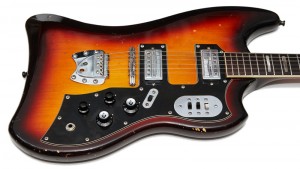
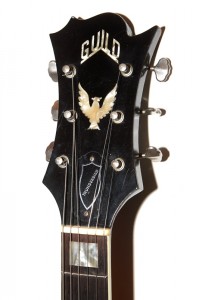
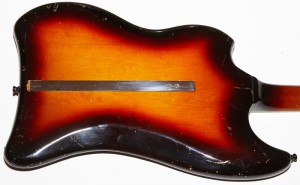
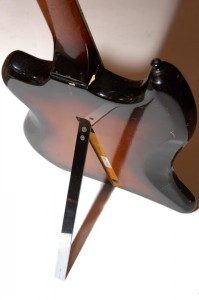
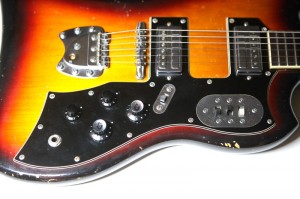
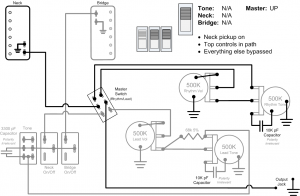
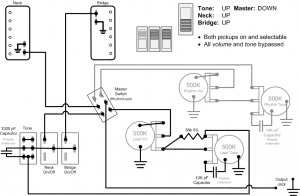
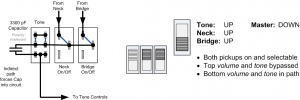
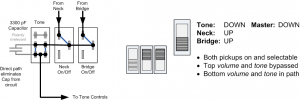
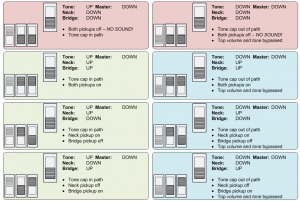
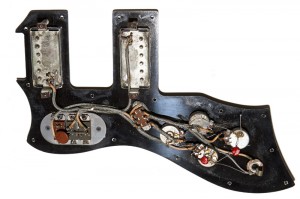
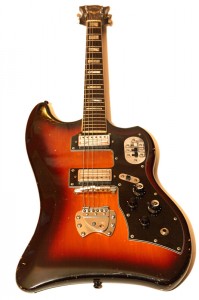

Hi Gary,
It was a great reading, interesting and enjoyable at the same time!
And I appreciate how it must be difficult to get technical but not boring and crystal clear…
After reading your article, there is still a question hovering in my ignorant mind,
and looking at one of the diagrams, it looks like you may have the answer.
Let’s say combination 1 is master down neck up tone down
And combination 2 is master up
Both only use the neck pickup, so… should they sound the same?
(there is a difference though, the 68k 5%, no idea if it account for something, but is sure is not there between volume and tone used in the master up position)
Thanks again for your article,
Sebastien
Thanks for you comment. While there is a difference in values, I could not hear a difference in the two positions as you described.
One of the cool side-benefits of this design is that I could set two different tone/volume settings for the neck pickup, and then switch between them using the master rhythm/lead switch.
BTW, the tone pots I pulled out were 1M and an unknown value that measured 44k, but they were toast and I don’t think they were original. I’d need another S200 to compare to see what “normal” is for these guitars.
As you describe, this can work like a Jazzmaster or a Jaguar with better pickups (IMHO). I’ve always doted on these guitars, kicked myself for not buying the beautiful cherry one in the music shop in the 60’s. I’m glad they’re reissuing and I’ll probably buy one. Thanks for your insightful assessment!
Hey Gad! I I know I have one of these to Guild Guitars. Would you be interested in redoing mine?
Maybe – email me at gad@gad.net and let’s chat about it.
Gad,
You done it this time, you unraveled a secret so deep as the affect civilization from this moment on.
It would appear that Guild used the same idea as the Fender Jaguar for their control set and, IMO, it’s a brilliant concept. I would think of it as having two preset sounds and a master switch to choose between those sounds on the fly. At one point in time I had a Jaguar and that is exactly how I used the controls. With slide switches and thumb wheels you don’t want to adjust your sound in the heat of the moment but you can quickly setup a lead sound and a rhythm sound for every song you play. It may very well be the most useful control set ever designed and the S200 was somewhat lost to antiquity until you brushed aside the scorpions, scarabs and asps, and decoded this ancient message from the Pharaohs of Hoboken. 🙂
I should also add that the HB1 mini humbucker is the best pickup ever. It has the clarion voice of a Filtertron but it gets down and dirty pretty well, too.
Gary,
An interesting read. You guided me through the purchase of my first Guild electric (An ’81 Starfire 4 with HB1’s) and I’ve been following your blog ever since 😉
Bob (MLBob on LTG)
I wish I could find one for sale. 🙁
Great article!!
I have some questions about wiring, please, if you can answer I thank:
1- tone capacitors (10k) are original? What kind? ceramic, paper-in-oil, etc?
2 – The key capacitor “tonality” (in white) is original? What kind is it?
Thanks for listening.
OK, this is an old, original model…Have you tried or played the re-issues? One of them is calling my name…
Thanks…
Mark
Thanks for your comment. I have not yet played one of the new ones.
I just wanted to add that I now have a Newark Street S200 Thunderbird in-hand and will be reviewing it as time permits.
This Article is Gold for me, thanks. I recently acquired an old Thunderbird from the 60’s. Unfortunately it’s in bad shape, especially the Electronics have been heavy Modified to add some Out-of-Phase Sounds. One Humbucker has been Replaced by an Dimarzio, but I got a new LB1 from Guild that fits. I’ll try to get it back to it’s Original Wiring, based on your Diagrams. Although I’m not good at Soldering at all, I’ll give it a try.